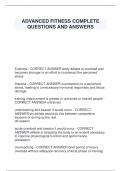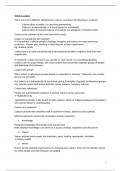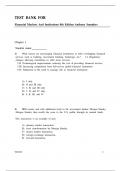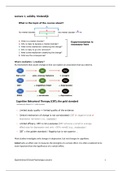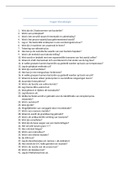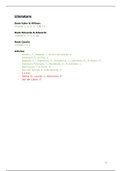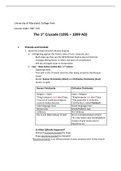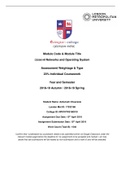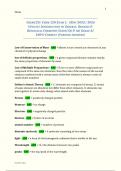assessment of the effectiveness of
implemented economic policies and
regulatory changes following the
recession”
Student name: Pietro Negri
Student number: 10393110
Major: Social Sciences, focus on Economics track
Name supervisor: Dr. B. Bruegemann
Name reader: Dr. R. Luttens
Name tutor: Mrs. B. A. Garcia
Capstone Thesis submitted in partial fulfilment of the requirements
for the degree of Bachelor of Arts
Date: 27-05-2015
1
,Word count: 9453
Abstract
The global financial crisis of 2008, which commenced from the burst of the
housing bubble in the United States, was the worst recession since the
Great Depression of the late 1920s. Seven years after this crisis arose,
research has identified the main causes and culprits of the crisis: an
increase homeownership push, low interest rates, easy lending and weak
banking and rating agency regulation. To alleviate the pressure of the
financial crisis, certain policies were implemented in the US to ensure
financial stability. The essential policies following the recession were
conventional and unconventional monetary policy tools, the adoption of
the Economic Stimulus Act (ESA) and the Troubled Asset Relief Program
(TARP). In addition to these policies, a few essential regulatory changes,
namely the creation of the Financial Stability Board (FSB) – and
subsequent Basel III – and the Dodd Frank Wall Street Reform and
Consumer Protection Act (DFA), were implemented to target the culprits
and loopholes exploited during the financial crisis as to prevent any
similar event from happening in the future. An analysis of post-2008
policies and regulatory reforms shows that these were mostly effective in
combatting both the recession and the culprits of the crisis but that, with
a few exceptions, these had visible flaws that significantly decreased their
effectiveness and impact on the economy.
2
,Table of Contents
Title
Page………………………………………………………………………………………….
…….…………………………… 1
Abstract………………………………………………………………………………………
………………………….…………… 2
Thesis
Statement……………………………………………………………………………………
……………….…………… 4
Introduction…………………………………………………………………………………
……………………….…………….. 4
Causes of the Global Financial
Crisis………………………………………………………………….…………………. 5
Post-Recession Economic Policies and Regulatory
Changes…………………………………………………. 8
Policies………………………………………………………………………………………
…………………………….. 8
Economic Stimulus Act (ESA)……………………………………….
…………………….………… 8
Monetary Policy………………………………………………………..
…………………………………. 9
Troubled Asset Relief Program (TARP)…………………….
…………………………………… 9
Regulation………………………………………………………..
…………………………………………………… 10
Financial Stability Board (FSB)……………………………….
…………………………………… 11
3
, Dodd-Frank Act (DFA)…………………………………………..
……………………………………. 11
Analysis of the Effectiveness and Comprehensiveness of the Implemented
Changes………… 13
ESA……………………………………………………………………………………………
…………………………… 13
Monetary
Policy…………………………………………………………………………………………
………….. 14
TARP……………………………………………………………………………………………
………………………… 15
FSB……………………………………………………………………………………………
…………………………… 16
DFA……………………………………………………………………………………………
…………………………… 18
Conclusion……………………………………………………………………………………
…………………………………… 21
Appendix……………………………………………………………………………………
……………………………………… 24
References……………………………………………………………………………………
…………………………………… 24
Introduction
After the burst of the .com bubble, as a tool to escape from the recession
the Federal Reserve (Fed) had to lower interest rates to encourage people
4

